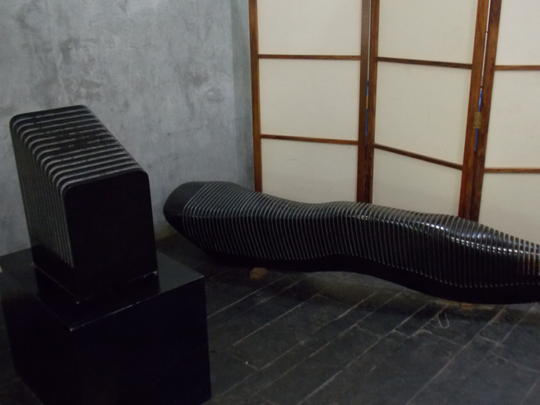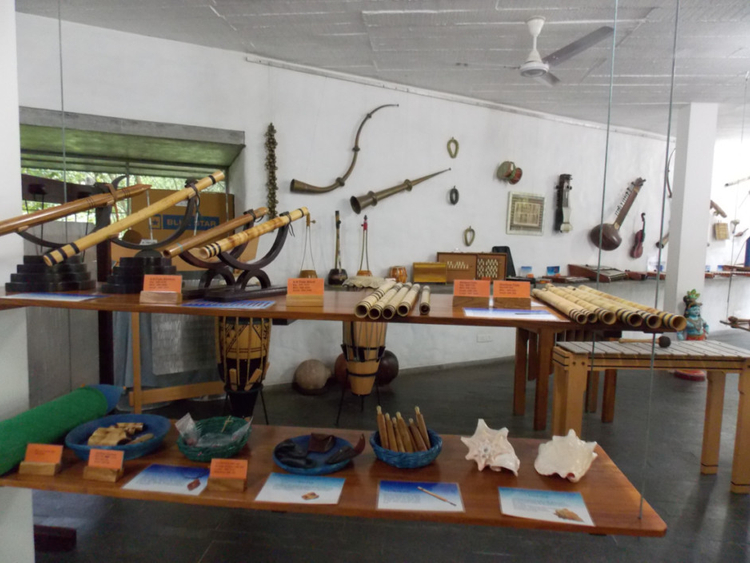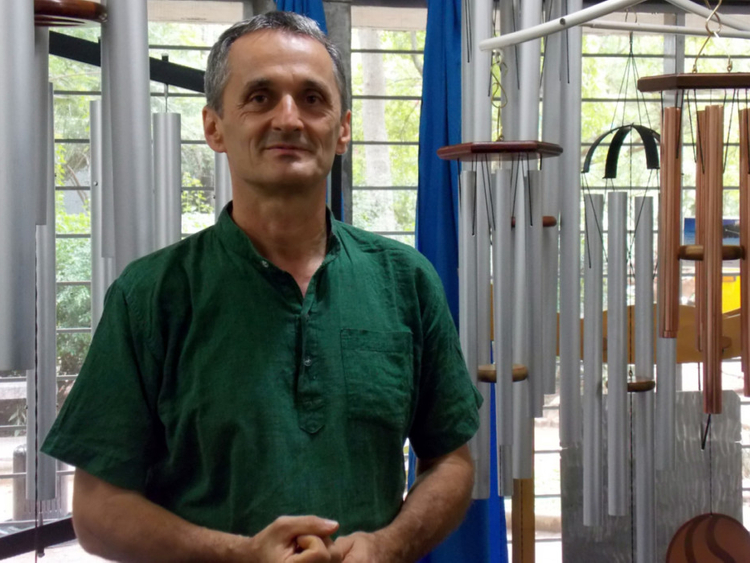
It was as if I could not only see the magic unfold before my eyes, but also hear it, each musical note a sonorous reflection of its source.
“A singing stone, really?” I ask, incredulous. Karthik, the young man standing beside a shiny granite block, happily demonstrates again. He wets his hands in a bowl of water and rubs the stone with them. And sure enough, the gentle melody fills the room once more.
“Will that also sing?” I ask Karthik, pointing to a long, serpentine black granite object adjacent to the block.
Once again Karthik wets his hands and strokes the stone. The seemingly lifeless stone comes alive with a musical sound. I wonder if there is a technique to coaxing the stone to “sing”.
Karthik smiles, “Why don’t you try?”
I do, and as if on cue, the stone emits the same note, soft and soothing. Beaming, I try my hand on an egg-shaped ebony granite. Another musical note fills the air.
These unusual stone musical instruments are on display at the showroom of Svaram, a community enterprise in Auroville, a universal township 150 kilometres south of Chennai.
Svaram houses all sorts of musical instruments, conventional and not so conventional. And, each bears its own signature tune. From wind chimes that break into strains of classical Indian music when teased by a breeze to the rhythmic beat of bamboo shakers, clap sticks and seed rattles, dulcet notes are all around. If the swishing ocean drums transport you to a tranquil beach, the tinkling xylophones compel you to join in the notes.
Svaram was launched in 2003 by Aurelio C. Hammer, an Austrian ethno-musicologist, sound researcher and sound healer, as part of a Unesco-endorsed project of Auroville.
What began as a vocational training project for youngsters (mostly school dropouts) gradually grew to a sustainable income generating venture with 43 workers today.
Svaram is recognised in the UN Compendium “Music as a Global Resource” among one of the first 100 selected projects that work through a socio-cultural creative enterprise.
From making musical instruments initially, Svaram gradually branched out into a centre for healing through sound, a vocational training centre for instrument makers, and then taking on corporate projects on sound installations for interiors and outdoor spaces.
Their client list includes the who’s who from the Indian music community, such as drummer Sivamani and Carnatic musician Mahesh Vinayakaram. Among the international clients are Peruvian percussionist and composer Manongo Mujica, German pianist and composer Prof Klaus Fessmann, Japanese keyboard player and percussionist Stomu Yamashta and Swedish percussionist Emelie Sjoestroem.
Reaching out
Karthik’s journey into the realm of sound was unplanned. At 15, this school dropout was making a living as a painter. He lived with his parents in a village near Auroville.
While cycling to work, he often noticed a “white man sitting under the trees and playing a flute or a guitar”.
This was his first impression of Hammer.
“Aurelio carried with him several instruments, each different from the other and he played them. I was fascinated. Sometimes he sang aloud. I soon got drawn into his music,” says Karthik.
When an ailment forced him to quit painting, Karthik found time to interact with Hammer. He helped Hammer carry his instruments and sometimes assisted him while he repaired them.
“Initially Aurelio was not confident of training me,” says Karthik who, as co-founder of Svaram, today manages the enterprise.
From a diffident teenager who was clueless about his life to a confident 30-year-old father of two, Karthik has travelled to Hawaii, Germany and Austria to meet clients. “I have trained people on making musical instruments and demonstrated sound healing.”
Svaram has transformed not just Karthik’s life but the lives of many others, too.
Prakash, who heads the drums unit, did not study beyond grade nine. He trained under Hammer for three years and today in his unit 25 kinds of drums are crafted by hand.
Selvam’s story is similar. He, too, studied only until grade nine. Today he manages the metallophone department of Svaram.
Did N. Mahesh, a car mechanic ever contemplate making musical instruments? After meeting Hammer at a socio-cultural event, Mahesh joined Svaram and now takes care of the wind chimes unit. He also assists Hammer with his sound healing programmes.
Sundaram has been with Svaram for the past 18 years and is adept at making different kinds of wind chimes.
“Thanks to Aurelio’s training, I am enjoying what I do today,” says this former carpenter, also a trained musician.
Anand, 28, did not study beyond grade eight and worked as a construction labourer. He now tunes stringed instruments besides playing drums in Svaram’s band.
And then there’s Shankar, who is more than pleased to show you around the flute unit that he heads. A music lover, he joined Svaram with the intention of learning music, but when he realised that he was not cut out for that, he chose to make musical instruments instead.
“People generally think of the Krishna bansuri when referring to flutes, but at Svaram, we make 12 types of flutes,” says this former electrician who did not study beyond standard 10. He shows me a clay flute (a small pot-like structure with four holes) and a double flute that produces two ragas.
“We also make the American native flute; there is a serpentine flute, too. Aurelio encourages us to try out new creations,” he says.
Manuel, who is in charge of the metallophone unit, adds, “Life at Svaram is peaceful, interesting and creative.” This former carpenter also assists Hammer in sound healing sessions.
Parasuraman, 35, also a former carpenter, says he knew nothing about music but is a happy man today crafting and tuning stringed instruments.
Back in 2009, Ulrike Strassmann, a successful corporate lawyer from Germany, visited Auroville on her visit to India, and met Hammer. He asked Strassmann if she could help with administrative work at Svaram, and she agreed. “Since my daughter was in primary school then, I took it up. At that time Svaram was a social business venture with a small turnover of Rs2.5 million [Dh137,976] and almost no profit.”
It was then that she met the bunch at Svaram for the first time.
Strassmann, 46, remembers asking them what their profession was, and all of them drew a blank. “We made them understand that they had an identity of their own as a flute-maker, percussion instrument maker, or a metallophone maker. Their families did not consider making musical instruments a worthy profession. So we invited their parents to see what their children were doing. With more people going to college, they were not happy about their children becoming craftsmen.”
Strassmann played the flute and piano but her new role at Svaram demanded that she learn about Indian music. “I learnt the difference between South and North Indian music, which is nice.”
It was also in 2009 that Svaram faced its big test. A German customer had placed an order for 450 wind chimes to be delivered within six weeks. The order had come at a time when a mentally disturbed young man started a fire that destroyed everything at Svaram just the year before. “The showroom, the computer, the records, everything was gone,” says Strassmann. “But sometimes, fire is a cleansing process. We started again and successfully shipped the order.”
With Svaram expanding its scope to accommodate corporate projects, new challenges lie in designing musical instruments and sound installations that are aesthetic and functional. “Technical details have to be adapted for the public. And, keeping in mind children and older people, we have to stimulate all target groups. It’s been an interesting journey. I got the opportunity to develop people,” says the mother of two.
The man behind Svaram
Hammer’s life story reads like an adventure tale.
Born in Austria, Hammer’s love affair with music began on the guitar when he was 12. By 19, he was well-trained to play classical compositions. “Whatever I played was with the help of a paper but I could not make music out of the heart,” Hammer says.
Keen on learning indigenous music from various parts of the world, he left home at 19, when he was still in college.
Hammer’s dream was to make it to the Marquesas Islands in the Pacific Ocean, a fantasy born from reading the books of Thor Heyerdahl, the Norwegian adventurer (known for his odyssey across the Pacific in a hand-built raft from South America, and sailing about 8,000 kilometres).
Hammer travelled to Canada first and then to Florida, eventually reaching the Marquesas Islands. Living amid indigenous people he noticed that there was music in everything they did. “From morning, they sang while working in the fields and fishing. Music was a celebration and it flowed from their heart. I soon learnt to compose my own music and also native medicine.”
Five years later he was back home in Austria but was disillusioned with the capitalist society there. Following a mystical experience he arrived in Pondicherry, India, in 1980, staying there for a few months.
Pondicherry beckoned him again in 1991 and Hammer moved to the township of Auroville. Involving himself in community outreach programmes for children and organising theatre workshops, he found his true calling.
When an American friend asked him to make a stringed instrument (a gift for his wife), Hammer took baby steps with Svaram. “He gave me a $100 bill, our first order at Svaram.”
Turning school dropouts into craftsmen of musical instruments did not come easy. “It was the challenge of communicating basic musical and acoustic principles in simple terms that made me dive deeper into understanding the core concepts of music and sound. In a way the blankness of the canvas was a great asset for creating from scratch, something new and un-programmed.”
Svaram made one of the world’s largest tuned wind chimes for Mumbai International Airport (Terminal 2). Measuring 16 metres in with 400 tubular bells weighing 900kg, this wind chime was part of a project done in association with noted designer Rajeev Sethi.
For the Centre for Indian Music Experience in Bengaluru, Svaram will create educative learning stations, interactive sound installations of tubular bells, plate gongs, singing stones, xylophones and other features that will allow visitors a direct encounter with the basic principles of sound and music.
On the anvil is a sound garden for a five-star hotel in New Delhi and a sound healing garden in Pune.
On a philosophical note, Hammer says, “Life is a great adventure of consciousness and love. I had the good fortune of having grown up from the bottom of the society structure, which equipped me with a warrior and pilgrim spirit to reach further on this evolutionary journey, without ever giving up, trusting the justice and learning guidance of life ... When faced with obstacles music always provided the necessary solace, encouragement and source of further inspiration.”
The singing stone
Specially selected black granite stones weighing 20 to 200kg are cut with diamond-coated saws to give a comb-like appearance. The sound is created by friction — the stone produces a sound with the slight rubbing action of the hands over the cut-inserted ribs, in a manner similar to rubbing the edge of a crystal glass with a wet finger.
Karthik says that some stones “reveal the music” within 10 days, while others take a month. And, there have been times when despite working on it for several days, the stone “refuses to sing”.
Mythily Ramachandran is a writer based in Chennai, India.














